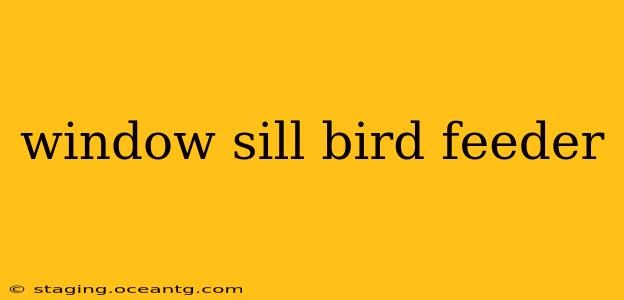Want to bring the beauty of nature right to your window? A window sill bird feeder offers a fantastic way to observe birds up close and personal, transforming your everyday view into a captivating wildlife spectacle. But choosing the right feeder and ensuring its successful operation requires some consideration. This comprehensive guide will help you select, install, and maintain the perfect window sill bird feeder, attracting a vibrant array of feathered visitors to your home.
What are the Benefits of a Window Sill Bird Feeder?
Window sill bird feeders provide unparalleled opportunities for birdwatching. Their proximity allows for detailed observation of bird behavior, plumage, and feeding habits, all from the comfort of your own home. This close-up view is especially rewarding for bird enthusiasts and nature lovers of all ages. Beyond the sheer enjoyment, they also contribute to supporting local bird populations by providing a supplemental food source.
What are the Different Types of Window Sill Bird Feeders?
The market offers a diverse range of window sill bird feeders, each with its own unique design and features. Understanding these differences will help you choose the best option for your needs and the type of birds you want to attract.
Suction Cup Feeders:
These are the most common type, easily attached to a clean windowpane with strong suction cups. They are typically small to medium-sized, ideal for smaller birds like finches and chickadees. Their simplicity makes them easy to clean and maintain.
Perch Feeders:
These feeders offer a small perch for birds to land on while feeding. They can be suction cup mounted or have other attachment methods. The perch design can help deter larger birds from dominating the feeder.
Tray Feeders:
Tray feeders provide an open platform for food, suitable for a wider variety of birds. However, they may also attract larger birds that could potentially intimidate smaller species. Choosing a smaller tray feeder can help mitigate this.
Tube Feeders:
While not strictly designed for window sills, some tube feeders can be adapted. These feeders typically dispense seeds or nectar through small holes, and are excellent for attracting hummingbirds and other nectar-loving birds.
How Do I Choose the Right Window Sill Bird Feeder?
Choosing the right window sill bird feeder depends on several factors:
- Size and Capacity: Consider the size of your window and the number of birds you expect to attract.
- Type of Food: Different feeders are designed for different types of birdseed, suet, or nectar.
- Material: Opt for durable, weather-resistant materials like polycarbonate or metal.
- Ease of Cleaning: Choose a feeder that is easy to disassemble and clean regularly to prevent the spread of disease.
- Suction Cup Strength: If using suction cups, ensure they are strong enough to withstand wind and the weight of the feeder and birds.
What Kind of Birdseed Should I Use in My Window Sill Bird Feeder?
The type of birdseed you use will significantly impact which birds you attract. Black oil sunflower seeds are a popular choice, as they are readily consumed by a wide variety of birds. Nyjer seeds are excellent for attracting finches, while suet caters to woodpeckers and other birds that appreciate high-fat options. Consider offering a variety of seeds to appeal to different species.
How Often Should I Clean My Window Sill Bird Feeder?
Regular cleaning is crucial to prevent the spread of disease and maintain a healthy environment for the birds. Aim to clean your feeder at least once a week, or more frequently in warm, humid weather. Remove old, spoiled food and wash the feeder with soap and water. Thoroughly rinse and allow it to dry completely before refilling.
Can I Use a Window Sill Bird Feeder in Winter?
Yes, you can absolutely use a window sill bird feeder in winter! Providing supplemental food during the colder months is especially important for birds, as food sources can become scarce. However, be mindful of potential ice buildup on the feeder and take extra care to clean it frequently to prevent freezing.
How Do I Attract More Birds to My Window Sill Bird Feeder?
Besides providing high-quality food, consider adding water sources like a small bird bath nearby. Planting native shrubs and trees around your feeder will also create a more welcoming habitat for birds. Avoid using pesticides and herbicides, as these can harm birds and their food sources.
What are Some Common Problems with Window Sill Bird Feeders?
Some common issues include suction cups failing, squirrels accessing the feeder, and ants or other insects being attracted to spilled seeds. Choosing high-quality suction cups, using squirrel-resistant feeders, and regularly cleaning spilled seeds can help mitigate these problems.
By understanding the various types of window sill bird feeders, selecting the right seed types, and implementing proper cleaning routines, you can transform your window into a thriving hub of avian activity. Enjoy the close-up views and the enriching experience of welcoming these beautiful creatures to your home.
